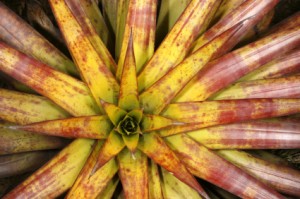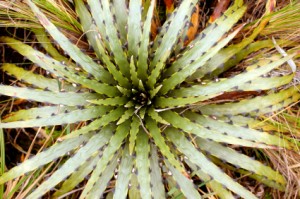Cryptanthus or Earth Stars
Author: Melanie Dearringer6 Comments
Care and Culture, Classification
Cryptanthus is a genus of plants found in the Bromeliaceae family. Cryptanthus bromeliads are unique in that they only grow terrestrially as opposed to many other bromeliads that can grow mounted on a substrate. The genus get its name from the Greek word meaning hidden flower. Cryptanthus are more commonly known as Earth Stars, a name they received because of the shape of their foliage. With over 1,200 different varieties, Cryptanthus have incredibly varied and beautiful foliage ranging from dark green and variegated to bright reds and pinks to silvery stripes. Most Cryptanthus grow close to the ground and can be as small as three inches in height. However, there are some species of Cryptanthus that can grow as tall as three feet.
Earth Stars are endemic to South America. More specifically, they can be found growing on Brazil’s rain forest floors. Unlike many other bromeliads, they grow in the soil. The canopies under which they grow, allows diffused sunlight through. Because of their adaptations to this environment, Cryptanthus have special care considerations.
Potting
 As opposed to other bromeliads that have very small root systems which only act as anchors, Cryptanthus has a more developed root system. Its roots can be expected to grow to at least the same width as its foliage. While their root systems are larger. a five or six inch pot should still provide adequate space for the plant to grow. Using plastic pots will help maintain moisture. It is wise to use a pot that is wider than it is deep. Earth Stars will thrive when potted in a medium that maintains some moisture. Specialty potting mixes are available at garden centers and nurseries. You can also mix your own with sand, peat and perlite.
As opposed to other bromeliads that have very small root systems which only act as anchors, Cryptanthus has a more developed root system. Its roots can be expected to grow to at least the same width as its foliage. While their root systems are larger. a five or six inch pot should still provide adequate space for the plant to grow. Using plastic pots will help maintain moisture. It is wise to use a pot that is wider than it is deep. Earth Stars will thrive when potted in a medium that maintains some moisture. Specialty potting mixes are available at garden centers and nurseries. You can also mix your own with sand, peat and perlite.
Humidity
Consider keeping your Earth Star in an area of the house that remains humid. Kitchens and bathrooms, for example, are generally more humid than other areas of the home. To increase humidity, you can fill a shallow tray with pebbles and water or you can run a humidifier near your plant. Areas where other houseplants are kept will also have higher humidity.
Fertilizer
In order to maximize growth, Cryptanthus should be fertilized. Cryptanthus will thrive on any balanced fertilizer such as 10-10-10 or 14-14-14. It is important, however, to significantly dilute the solution down to a quarter of the strength recommended. This highly diluted solution can be used every time you water. The Cryptanthus Society recommends using a time release granular fertilizer when first planting pups.
Pups
 Like most bromeliads, Cryptanthus only flower once during their lifetime. Almost all Cryptanthus have small, delicate white flowers near their leaves. Sometime before it dies, a healthy plant will produce pups, exact clones of the mother plant, that can be removed and then potted in their own growing medium. Depending on the variety of Cryptanthus, the pups can be found either at the end of stolons, at a leaf axis, or at the base of the plant. Pups should be allowed to grow attached until they are roughly 1/3 to 1/2 the size of the mother plant after which they can be removed and potted. You may have to stake the pup until it develops sufficient roots to hold itself up.
Like most bromeliads, Cryptanthus only flower once during their lifetime. Almost all Cryptanthus have small, delicate white flowers near their leaves. Sometime before it dies, a healthy plant will produce pups, exact clones of the mother plant, that can be removed and then potted in their own growing medium. Depending on the variety of Cryptanthus, the pups can be found either at the end of stolons, at a leaf axis, or at the base of the plant. Pups should be allowed to grow attached until they are roughly 1/3 to 1/2 the size of the mother plant after which they can be removed and potted. You may have to stake the pup until it develops sufficient roots to hold itself up.
Temperature
Cryptanthus can survive in a wide range of temperatures but they thrive in temperatures between 60 and 85 degrees Fahrenheit. They are ideal for indoor growth but can also grow well outdoors in many moderate climates. Mulching when the weather becomes colder can protect the roots during the winter and allow the plant to produce offsets. The plant can also survive warmer temperatures, upwards of 100 degrees Fahrenheit as long as it is kept moist by humidifiers, manually misting water onto the plants, or is located outdoors in a humid environment.
Light
Cryptanthus varieties require differing amounts of lights. Most Cryptanthus prefer indirect sunlight. Shade from tall trees outdoors or a sunny room without direct sun exposure is ideal for Cryptanthus. As mentioned above, Cryptanthus are adapted to survive under the cover of trees in humid climates. Too much direct sun can cause bleached or sunburned areas on the plant’s leaves. If your plant seems stressed and these marks appear, move your bromeliad to a spot with less direct sunlight. On the other hand, if your plant does not get enough light it will begin to look light green in color.
Troubleshooting
Cryptanthus experience few pests, but like all bromeliads they are most susceptible to mealybugs and scale. Mealybugs, a type of scale, look like small cottony masses. They can usually be controlled through manual removal or swabbing with rubbing alcohol. In outdoor environments, natural predators such as ladybugs and parasitic wasps should keep mealybug and scale infestations under control. If manual removal does not improve the situation, chemical insecticides can be used. See your local county extension agent for recommendations on the safest products for both people and the plants.
Varieties
Because Cryptanthus thrive in humidity and many varieties are lower growing, they are ideal for use in terrariums. Cryptanthus bivittatus is a beautiful rose and purple colored plant that grows no taller than 8 inches high. This variety would be an excellent and colorful addition to a terrarium.
There are many varieties of Cryptanthus with vast differences in appearance. Understanding the names of bromeliads can help you determine what a particular species of Cryptanthus will look like. The South East Michigan Bromeliad Society defines the following terms:
- bivittatus -having two stripes
- coriaceus -leather-like
- lacerdae -tattered
- latifolius -wide leaved
- marginatus -having margins
- zonatus -having zones, i.e. bands
Leaf color:
- aurantiacus -orange
- carnosus -pink (i.e. meat-colored)
- fuscus- dark, dusky
- viridis -green.
Growth habit:
- acaulis -stemless
- bromelioides -like a bromelia,
- scaposus -having ascape
- sinuosus -sinuous, winding
Other species may be named for specific people.
Tips to Remember
Cryptanthus generally make excellent houseplants. Remember to keep the plant moist and in humid conditions. This is especially important when you use central heat or air conditioning as the moving air has a tendency to be drier. Many Cryptanthus can also tolerate outdoor conditions in temperate climates. Remember to mulch for protection during the winter and expect some damage to the leaves if temperatures drop below freezing. Fertilize your Earth Star to encourage growth, repot pups, and continue enjoying your Cryptanthus for years to come!
Sources
“What is a Cryptanthus?” Bromeliad Society of South Florida. <http://www.bssf-miami.org/what-is-a-cryptanthus.htm>
Goff, Penrith, “Cryptanthus Cultural Information” S.E. Michigan Bromeliad Society <http://bromeliads.gardenwebs.net/cryptanthus.culture.htm>
“How to Grow Cryptanthus” The Cryptanthus Society <http://fcbs.org/cryptanthussociety/CS_CultureSheet.pdf>
“Cryptanthus” Wikipedia <http://en.wikipedia.org/wiki/Cryptanthus>
“Cryptanthus Bivittatus” Wikipedia <http://en.wikipedia.org/wiki/Cryptanthus_bivittatus>
6 Responses to “Cryptanthus or Earth Stars”
Leave a Reply

Resource Download
Hechtia Care Cheat Sheet
Learn how to care for your Hechtia bromeliad with this quick and easy informational guide.
Learn More
Ask an Expert
Questions about bromeliads?
Our experts love a challenge!
Photo of the Week
Submit your photo to be featured on the blog!
More Photo of the Week Winners
Submit Photo








Gave good info. Would like to see more pictures.
Good information on bromelaids. Would like to see more pictures so I can see what kind I have. Don’t know how to water, if from the top in the center or on the mud if I can get to it. The leaves also are ruff and you can get scratched. I am 83 years old. Help
Kudos for an interesting post. I’ve been hunting for this type of data for for ages now.
I’ve read to water in the center of the plant like a bromeliad.
Good information about this plants. Thank you.
Very informational site